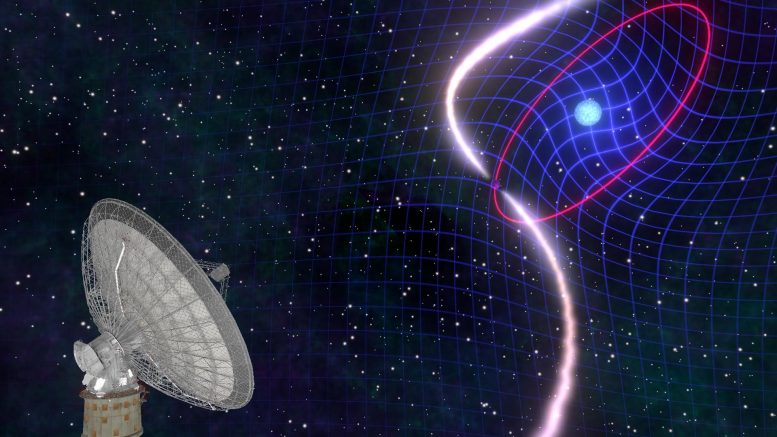
Artist’s depiction of ‘frame-dragging’: two spinning stars twisting space and time. Credit: Mark Myers, OzGrav ARC Centre of Excellence
Astronomers witness “frame-dragging” — the dragging of space-time in stellar cosmic dance.
An international team of astrophysicists led by Australian Prof Matthew Bailes from OzGrav has found exciting new evidence for ‘frame-dragging’ — how the spinning of a celestial body twists space and time — after tracking the skies for almost 20 years.
An international team of astrophysicists led by Australian Professor Matthew Bailes, from the Australian Research Council Centre of Excellence of Gravitational Wave Discovery (OzGrav), has shown exciting new evidence for ‘frame-dragging’ — how the spinning of a celestial body twists space and time — after tracking the orbit of an exotic stellar pair for almost two decades. The data, which is further evidence for Einstein’s theory of General Relativity, is published today (January 31, 2020) in the prestigious journal, Science.
More than a century ago, Albert Einstein published his iconic theory of General Relativity — that the force of gravity arises from the curvature of space and time and that objects, such as the Sun and the Earth, change this geometry. Advances in instrumentation have led to a flood of recent (Nobel prize-winning) science from phenomena further afield linked to General Relativity. The discovery of gravitational waves was announced in 2016; the first image of a black hole shadow and stars orbiting the supermassive black hole at the center of our own galaxy was published just last year.
Animation depicting a neutron star orbiting a rapidly-spinning white dwarf. The white dwarf’s spin drags the very fabric of space-time around with it, causing the orbit to tumble in space. Credit: Mark Myers, OzGrav ARC Centre of Excellence.
Almost twenty years ago, a team led by Swinburne University of Technology’s Professor Bailes — director of the ARC Centre of Excellence in Gravitational Wave Discovery (OzGrav) — started observing two stars rotating around each other at astonishing speeds with the CSIRO Parkes 64-meter (210-foot) radio telescope. One is a white dwarf, the size of the Earth but 300,000 times its density; the other is a neutron star which, while only 20 kilometers (12 miles) in diameter, is about 100 billion times the density of the Earth. The system, which was discovered at Parkes, is a relativistic-wonder system that goes by the name ‘PSR J1141-6545’.
Before the star blew up (becoming a neutron star), a million or so years ago, it began to swell up discarding its outer core which fell onto the white dwarf nearby. This falling debris made the white dwarf spin faster and faster, until its day was only measured in terms of minutes.
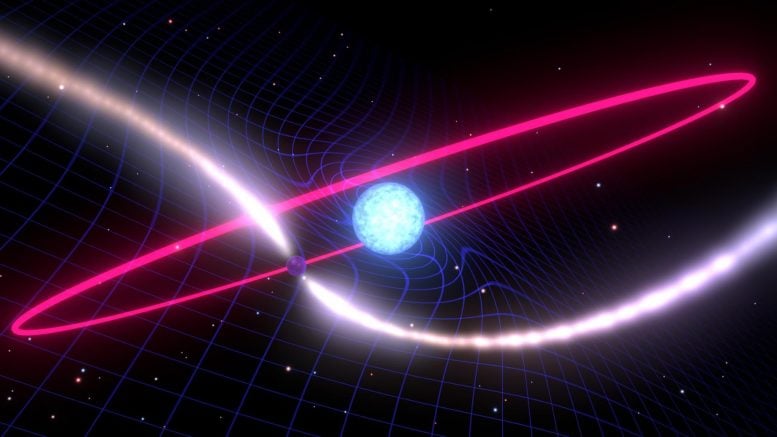
Artist’s depiction of a rapidly spinning neutron star and a white dwarf dragging the fabric of space time around its orbit. Credit: Mark Myers, OzGrav ARC Centre of Excellence
In 1918 (three years after Einstein published his Theory), Austrian mathematicians Josef Lense and Hans Thirring realized that if Einstein was right all rotating bodies should ‘drag’ the very fabric of space time around with them. In everyday life, the effect is miniscule and almost undetectable. Earlier this century, the first experimental evidence for this effect was seen in gyroscopes orbiting the Earth, whose orientation was dragged in the direction of the Earth’s spin. A rapidly spinning white dwarf, like the one in PSR J1141-6545, drags space-time 100 million times as strongly!
A pulsar in orbit around such a white dwarf presents a unique opportunity to explore Einstein’s theory in a new ultra-relativistic regime.
Lead author of the current study, Dr. Vivek Venkatraman Krishnan (from Max Planck Institute for Radio Astronomy — MPIfR) was given the unenviable task of untangling all of the competing relativistic effects at play in the system as part of his Ph.D. at Swinburne University of Technology. He noticed that unless he allowed for a gradual change in the orientation of the plane of the orbit, General Relativity made no sense.
MPIfR’s Dr. Paulo Friere realized that frame-dragging of the entire orbit could explain their tilting orbit and the team presents compelling evidence in support of this in today’s journal article — it shows that General Relativity is alive and well, exhibiting yet another of its many predictions.
The result is especially pleasing for team members Bailes, Willem van Straten (Auckland University of Tech), and Ramesh Bhat (ICRAR-Curtin) who have been trekking out to the Parkes 64m telescope since the early 2000s, patiently mapping the orbit with the ultimate aim of studying Einstein’s Universe. ‘This makes all the late nights and early mornings worthwhile’, said Bhat.
Expert commentary:
Lead author Vivek Venkatraman Krishnan, Max Planck Institute for Radio Astronomy (MPIfR): ‘At first, the stellar pair appeared to exhibit many of the classic effects that Einstein’s theory predicted. We then noticed a gradual change in the orientation of the plane of the orbit.’
‘Pulsars are cosmic clocks. Their high rotational stability means that any deviations to the expected arrival time of its pulses is probably due to the pulsar’s motion or due to the electrons and magnetic fields that the pulses encounter.’ ‘Pulsar timing is a powerful technique where we use atomic clocks at radio telescopes to estimate the arrival time of the pulses from the pulsar to very high precision. The motion of the pulsar in its orbit modulates the arrival time, thereby enabling its measurement.’
Dr. Paulo Freire: ‘We postulated that this might be, at least in part, due to the so-called “frame-dragging” that all matter is subject to in the presence of a rotating body as predicted by the Austrian mathematicians Lense and Thirring in 1918.’
Professor Thomas Tauris, Aarhus University: ‘In a stellar pair, the first star to collapse is often rapidly rotating due to subsequent mass transfer from its companion. Tauris’s simulations helped quantify the magnitude of the white dwarf’s spin. In this system, the entire orbit is being dragged around by the white dwarf’s spin, which is misaligned with the orbit.’
Dr. Norbert Wex, Max Planck Institute for Radio Astronomy (MPIfR): ‘One of the first confirmations of frame-dragging used four gyroscopes in a satellite in orbit around the Earth, but in our system, the effects are 100 million times stronger.’
Evan Keane (SKA Organisation): ‘Pulsars are super clocks in space. Super clocks in strong gravitational fields are Einstein’s dream laboratories. We have been studying one of the most unusual of these in this binary star system. Treating the periodic pulses of light from the pulsar like the ticks of a clock we can see and disentangle many gravitational effects as they change the orbital configuration, and the arrival time of the clock-tick pulses. In this case, we have seen Lens-Thirring precession, a prediction of General Relativity, for the first time in any stellar system.’
From Willem van Straten (AUT): ‘After ruling out a range of potential experimental errors, we started to suspect that the interaction between the white dwarf and neutron star was not as simple as had been assumed to date.
Reference: “Lense–Thirring frame dragging induced by a fast-rotating white dwarf in a binary pulsar system” by V. Venkatraman Krishnan, M. Bailes, W. van Straten, N. Wex, P. C. C. Freire, E. F. Keane, T. M. Tauris, P. A. Rosado, N. D. R. Bhat, C. Flynn, A. Jameson and S. Osłowski, 31 January 2020, Science.
DOI: 10.1126/science.aax7007

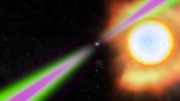
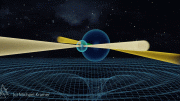
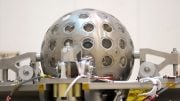
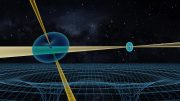
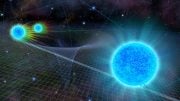
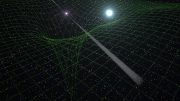
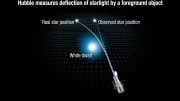
Is it possible for particles to ‘surf’ gravity waves and to ‘tack’ them as some sail boats (catamarans) do with the wind exceeding the speed of the wind?
Just asking for a friend.
jim oss just asking for a friend
catamarans sail boats travelling surfing on the ocean waves
with ocean waves travelling at 10 kilometres an hour
being tacked by winds of 20 kilometres an hour
and these catamaran sail boat surf wave move exceeding the wind speed and achieve approx 25 kilometres an hour locomotion
is this possible tell your friend it happens every day of the week out there
particles of light journeying across cosmic space millions of light years destination distance
being tacked by a cosmic forces the speed of 10 kilometres a second
can these particles exceed the speed of light ie 300,005 kilometres a second
well ask your friend to scientifically name me the tacking cosmic force
and then we will inform them if it is possible
we have an object 12,000 kilometres in diameter massive white dwarf like our earth
we have an object 10 kilometres in diameter a pulsar like a meteorite comet asteroid
they rotate around each other in three dimensional plus time
now according to earth science the earth 12,000 kilometres precesses
so what cant the above object the white dwarf
When a massive object rotates, general relativity predicts that it pulls the surrounding spacetime around with it, a phenomenon known as frame-dragging.
now could you advise me how a 12,010 kilometre object could frame drag spacetime